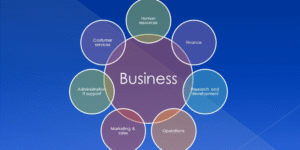Effective meetings are a cornerstone of organisational success, fostering communication, innovation, and alignment among teams. However, many organisations suffer from unproductive meetings that waste time and resources. Amazon founder Jeff Bezos developed a distinctive approach to meetings that exemplifies how structured communication, small teams, and customer-centric thinking can transform productivity. The four golden rules—the Two-Pizza Rule, the Empty Chair Rule, No PowerPoint, and Begin with Silence—represent Bezos’s philosophy of lean communication, critical thinking, and efficiency. This article critically examines these principles through the lens of leadership and organisational behaviour, integrating insights from scholarly research and business literature.
1.0 The Two-Pizza Rule: Small Teams, Big Impact
Bezos’s Two-Pizza Rule posits that no meeting should include more people than can be fed by two pizzas—typically five to nine participants (Gallo, 2022). The rationale is simple: smaller groups foster positive synergy, enhance accountability, and accelerate decision-making. According to Dyer and Dyer (2019), this approach minimises social loafing and groupthink, which often plague large teams.
From a management theory perspective, the Two-Pizza Rule aligns with Belbin’s Team Role Theory, which emphasises the need for complementary yet limited team members to maintain efficiency and balance (Belbin, 2010). Similarly, Edmondson and Besieux (2021) argue that psychological safety and effective communication are more achievable in smaller groups, where individuals feel heard and accountable.
At Amazon, this principle has been instrumental in promoting agile leadership. As Ncube et al. (2024) discuss, small, autonomous “two-pizza teams” allowed Amazon to scale rapidly while preserving innovation and ownership. This decentralised model mirrors the agile methodology adopted in software development, which values adaptability, communication, and iterative progress (Bömelburg & Gassmann, 2024).
Example: The success of Amazon Prime originated from a small, independent team operating under the Two-Pizza Rule, which expedited decision-making and experimentation (Bryar & Carr, 2021).
2.0 The Empty Chair Rule: Embedding Customer Obsession
Another of Bezos’s golden rules is the Empty Chair Rule, where an empty seat is placed in every meeting to symbolise the customer’s presence. This symbolic act ensures that all discussions consider customer impact—a direct reflection of Amazon’s core principle of customer obsession (Shah, 2024).
From the perspective of stakeholder theory, this practice embeds the voice of the customer within strategic decision-making (Freeman, 2010). The empty chair acts as a moral compass, reminding participants to view issues through the lens of the end-user experience.
According to Solanki (2019), this approach has reshaped Amazon’s corporate culture by reinforcing empathetic decision-making. Leaders are compelled to ask: “How does this decision improve the customer’s life?” Such reflection aligns with transformational leadership theory, wherein leaders inspire followers to prioritise long-term values over short-term gains (Adigwe, 2024).
Example: When Amazon was deciding whether to launch Kindle, Bezos reportedly invoked the Empty Chair principle to emphasise the customer’s need for accessibility and convenience in digital reading. This customer-first mindset ultimately led to the Kindle’s success in revolutionising the publishing industry.
3.0 No PowerPoint: Encouraging Depth Over Flash
Bezos famously banned PowerPoint presentations in Amazon’s meetings, replacing them with six-page narrative memos that participants read silently at the beginning of the meeting. As explained in Working Backwards (Bryar & Carr, 2021), Bezos believed that PowerPoint oversimplifies ideas, encourages superficial thinking, and inhibits deep understanding.
This rule reflects a cognitive approach to communication, prioritising comprehension over persuasion. Written memos compel the presenter to structure thoughts coherently, ensuring that every idea is justified with evidence and context. According to Rossman and McCaffrey (2024), narrative memos promote critical reasoning and shared understanding, reducing the ambiguity that arises from bullet-point slides.
Research supports this reasoning: written narratives enhance information retention and collective comprehension in decision-making settings (Bingham & McDonald, 2022). Moreover, by replacing visual presentation with textual reasoning, Bezos reinforced Amazon’s learning culture, aligning with Senge’s (1990) concept of the learning organisation.
Example: During major product reviews, Amazon executives spend the first 20 minutes reading these memos in silence, ensuring that everyone starts from an informed position before discussion. This has become a hallmark of Amazon’s meeting culture, promoting intellectual discipline.
4.0 Begin with Silence: Fostering Focus and Equal Understanding
The final rule, Begin with Silence, complements the No PowerPoint approach. Meetings at Amazon start with 20 minutes of silent reading of the memo, allowing participants to engage deeply with the material before discussion begins. Bezos justified this by noting that 95% of meeting participants in traditional organisations lose focus or miss critical details when relying on verbal summaries (Dumaine, 2020).
From a psychological standpoint, this practice enhances cognitive readiness and equity in participation. It eliminates the disadvantage for those who may not have pre-read the material and reduces anchoring bias, where the first speaker disproportionately influences the group’s decision (Edmondson & Besieux, 2021).
This practice echoes the reflective thinking model proposed by Dewey (1933), where deliberate reflection precedes judgment. By institutionalising silence, Bezos ensured that discussions were grounded in informed reasoning rather than reactionary dialogue.
Example: The adoption of this rule has led to more focused discussions in Amazon’s product and operational meetings. Participants report higher levels of clarity, with decisions reached through data-driven consensus rather than dominance of authority figures (Khandro, 2020).
Integrative Perspective: The Leadership Logic Behind the Rules
Collectively, Bezos’s four rules exemplify transformational leadership and agile management principles. As Adigwe (2024) and Etukuru (2018) highlight, transformational leaders cultivate environments that empower autonomy, encourage innovation, and align team efforts with a higher purpose. The Two-Pizza Rule decentralises authority, the Empty Chair Rule embeds ethical orientation, No PowerPoint fosters intellectual rigour, and Begin with Silence institutionalises focus and fairness.
These practices also demonstrate Bezos’s systemic thinking, a core feature of leadership 4.0, where collaboration, empathy, and adaptability replace hierarchical control (Kelly, 2018). They collectively support Amazon’s ability to sustain organisational agility amid growth and complexity (Bömelburg & Gassmann, 2024).
Critical Evaluation
While Bezos’s principles have driven success, critics argue that they may not be universally applicable. The Two-Pizza Rule, for instance, assumes a culture of self-management and accountability that may not exist in all organisations. As Dyer and Dyer (2019) note, small teams can also fragment communication and foster competition if not properly aligned with shared goals.
Moreover, the No PowerPoint rule may pose challenges in creative or visual industries where imagery and prototyping are central to communication. Nonetheless, the underlying philosophy—clarity over charisma—remains broadly applicable across contexts.
Organisations such as Google, Netflix, and Spotify have adopted similar principles, promoting small, empowered teams and customer-centric decision-making. This suggests that Bezos’s rules are not rigid prescriptions but adaptable frameworks for fostering agility and purpose-driven collaboration (Ukeni, 2022).
Jeff Bezos’s Four Golden Rules for Effective Meetings encapsulate a distinctive philosophy of leadership rooted in clarity, customer obsession, and disciplined communication. The Two-Pizza Rule ensures agility, the Empty Chair Rule embeds empathy, No PowerPoint fosters deep reasoning, and Begin with Silence promotes cognitive focus. Collectively, these practices have redefined how Amazon—and many other organisations—approach collaboration and innovation.
In an era where meeting fatigue undermines productivity, Bezos’s approach offers a model of efficiency grounded in simplicity and human focus. As organisations navigate increasing complexity, these rules serve as enduring lessons on how thoughtful leadership and structured communication can transform not just meetings, but entire corporate cultures.
References
Adigwe, C.S. (2024) Transformational Leadership: A Comparative Exploration of the Leadership Prowess of Jeff Bezos and Steve Jobs. Asian Journal of Economics, Business and Accounting.
Belbin, R.M. (2010) Team Roles at Work. Oxford: Butterworth-Heinemann.
Bingham, C.B. and McDonald, R.M. (2022) Productive Tensions: How Every Leader Can Tackle Innovation’s Toughest Trade-offs. Harvard Business Review Press.
Bömelburg, R. and Gassmann, O. (2024) Managing Growth Challenges Through Collaborative Scaling. Springer.
Bryar, C. and Carr, B. (2021) Working Backwards: Insights, Stories, and Secrets from Inside Amazon. London: Pan Macmillan.
Dumaine, B. (2020) Bezonomics: How Amazon is Changing Our Lives and What the World’s Best Companies Are Learning from It. Simon & Schuster.
Dyer, W.G. and Dyer, J.H. (2019) Beyond Team Building: How to Build High Performing Teams and the Culture to Support Them. Jossey-Bass.
Edmondson, A.C. and Besieux, T. (2021) ‘Reflections: Voice and Silence in Workplace Conversations,’ Journal of Change Management, 21(4), pp. 345–359.
Etukuru, R.R. (2018) The Art and Science of Transformational Leadership. New York: Routledge.
Gallo, C. (2022) The Bezos Blueprint: Communication Secrets of the World’s Greatest Salesman. Pan Macmillan.
Kelly, R. (2018) ‘Leadership Development and Structure—From Egosystems to Ecosystems,’ in Leadership 4.0. Springer.
Khandro, S.Y. (2020) Independent Final Report. The Ritsumeikan Academic Repository.
Ncube, L., Mahlangu, S., Kamango, K., and Ncube, N.M. (2024) The Role of Agile Leadership in the Success of a Contemporary Organisation. ResearchGate.
Shah, K. (2024) Assessing Leadership in Business: A Critical Investigation of Jeff Bezos. University of Connecticut.
Solanki, K. (2019) ‘To What Extent Does Amazon’s Success Be Accredited to Its Organisational Culture and Jeff Bezos’s Leadership Style?’ Archives of Business Research, 7(9), pp. 112–128.
Ukeni, C.S. (2022) ‘Strategy Behind the Business Success of Amazon: A Case Study,’ Texila International Journal of Management, 8(1), pp. 76–91.









